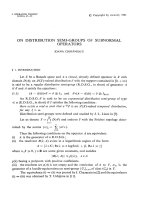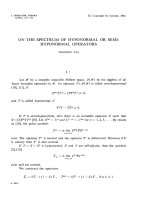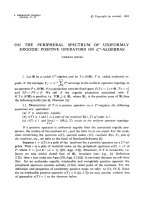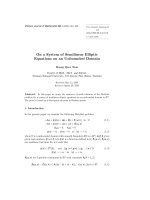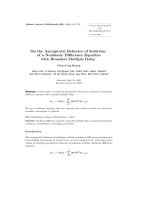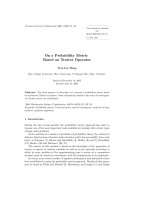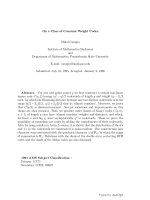Báo cáo toán học: " On a Partition Function of Richard Stanley" pptx
Bạn đang xem bản rút gọn của tài liệu. Xem và tải ngay bản đầy đủ của tài liệu tại đây (105.8 KB, 10 trang )
On a Partition Function of Richard Stanley
George E. Andrews
∗
Department of Mathematics
The Pennsylvania State University
University Park, PA 16802
Submitted: Sep 5, 2003; Accepted: Nov 19, 2003; Published: Jun 3, 2004
MR Subject Classifications: 05A17
In honor of my friend Richard Stanley
Abstract
In this paper, we examine partitions π classified according to the number r(π)
of odd parts in π and s(π) the number of odd parts in π
, the conjugate of π.The
generating function for such partitions is obtained when the parts of π are all N .
From this a variety of corollaries follow including a Ramanujan type congruence for
Stanley’s partition function t(n).
1 Introduction
Let π denote a partition of some integer and π
its conjugate. For definitions of these
concepts, see [1; Ch.1]. Let O(π) denote the number of odd parts of π. For example, if π
is6+5+4+2+2+1,thentheFerrersgraphofπ is
······
·····
····
··
··
·
Reading columns we see that π
is 6+5+3+3+2+1. Hence O(π)=2andO(π
)=4.
Richard Stanley ([4] and [5]) has shown that if t(n) denotes the number of partitions
π of n for which O(π) ≡O(π
) (mod 4), then
∗
Partially supported by National Science Foundation Grant DMS-0200047
the electronic journal of combinatorics 11(2) (2004), #R1 1
t(n)=
1
2
p(n)+f(n)
, (1)
where p(n) is the total number of partitions of n [1, p. 1], and
∞
n=0
f(n)q
n
=
i1
(1 + q
2i−1
)
(1 − q
4i
)(1 + q
4i−2
)
2
. (2)
Note that t(n) is Stanley’s partition function referred to in the title of this paper.
Stanley’s result for t(n) is related nicely to a general study of sign-balanced, labeled
posets [5]. In this paper, we shall restrict our attention to S
N
(n, r, s), the number of
partition π of n where each part of π is N, O(π)=r, O(π
)=s. In Section 2, we shall
prove our main result:
Theorem 1.
n,r,s0
S
2N
(n, r, s)q
n
z
r
y
s
=
N
j=0
N
j
; q
4
(−zyq; q
4
)
j
(−zy
−1
q; q
4
)
N−j
(yq)
2N−2j
(q
4
; q
4
)
N
(z
2
q
2
; q
4
)
N
, (3)
and
n,r,s0
S
2N+1
(n, r, s)q
n
z
r
y
s
=
N
j=0
N
j
; q
4
(−zyq; q
4
)
j+1
(−zy
−1
q; q
4
)
N−j
(yq)
2N−2j
(q
4
; q
4
)
N
(z
2
q
2
; q
4
)
N+1
, (4)
where
N
j
; q
=
(1−q
N
)(1−q
N−1
) (1−q
N−j+1
)
(1−q
j
)(1−q
j−1
) (1−q)
, for 0 j N ,
0 , if j<0 or j>N,
(5)
and
(A; q)
M
=(1− A)(1 − Aq) (1 − Aq
M−1
). (6)
From Theorem 1 follows an immediate lovely corollary:
Corollary 1.1.
n,r,s0
S
∞
(n, r, s)q
n
z
r
y
s
=
∞
j=1
(1 + yzq
2j−1
)
(1 − q
4j
)(1 − z
2
q
4j−2
)(1 − y
2
q
4j−2
)
. (7)
From Corollary 1.1, we shall see in Section 3 that
Corollary 1.2.
t(5n +4)≡ 0(mod5). (8)
Also,
the electronic journal of combinatorics 11(2) (2004), #R1 2
Corollary 1.3.
∞
n=0
t(n)q
n
=
Q(q
2
)
2
Q(q
16
)
5
Q(q)Q(q
4
)
5
Q(q
32
)
2
, (9)
where
Q(q)=(q; q)
∞
=
∞
j=1
(1 − q
j
). (10)
We conclude with some open questions.
2 The Main Theorem
We begin with some preliminaries about partitions and their conjugates. For a given
partition π with parts each N,wedenotebyf
i
(π) the number of appearances of i as a
part of π. The parts of π
in non-increasing order are thus
N
i=1
f
i
(π),
N
i=2
f
i
(π),
N
i=3
f
i
(π), ,
N
i=N
f
i
(π). (11)
Note that some of the entries in this sequence may well be zero; the non-zero entries
make up the parts of π
. However in light of the fact that 0 is even, we see that O(π
)is
the number of odd entries in the sequence (11) while
O(π)=f
1
(π)+f
3
(π)+f
5
(π)+ (12)
We now define
σ
N
(q, z,y)=
n,r,s0
S
N
(n, r, s)q
n
z
r
y
s
(q
4
; q
4
)
N
2
(z
2
q
2
; q
4
)
N+1
2
. (13)
Lemma 2.1. σ
0
(q, z,y)=1, and for N 1,
σ
2N
(q, z,y)=σ
2N−1
(q, z,y)+y
2N
q
2N
σ
2N−1
(q, z,y
−1
) (14)
σ
2N−1
(q, z,y)=σ
2N−2
(q, z,y)+zy
2N−1
q
2N−1
σ
2N−2
(q, z,y
−1
). (15)
Proof. We shall in the following be dealing with partitions whose parts are all some
given N.Welet¯π be that partition made up of the parts of π that are <N. In light of
(11) we see that if N is a part of π an even number of times, then O(π
)=O(¯π
)andif
N appears an odd number of times in π,thenO(¯π
)=N −O(π) (because the removal
of f
N
(π) from each sum in (11) reverses parity). Initially we note that the only partition
with at most zero parts is the empty partition of 0; hence σ
0
(q, z,y)=1.
the electronic journal of combinatorics 11(2) (2004), #R1 3
Next, for N 1,
σ
2N
(q, z,y)
(q
4
; q
4
)
N
(z
2
q
2
; q
4
)
N
=
π,parts2N
q
P
if
i
(π)
z
f
1
(π)+f
3
(π)+ +f
2N−1
(π)
y
O(π
)
=
π,parts2N
f
2N
(π)even
q
P
if
i
(¯π)+2Nf
2N
(π)
z
f
1
(π)+f
3
(π)+ +f
2N−1
(π)
y
O(¯π
)
+
π,parts2N
f
2N
(π)odd
q
P
if
i
(¯π)+2Nf
2N
(π)
z
f
1
(π)+f
3
(π)+ +f
2N−1
(π)
y
2N−O(π
)
=
1
(1 − q
4N
)
σ
2N−1
(q, z,y)
(q
4
; q
4
)
N−1
(z
2
q
2
; q
4
)
N
+
y
2N
q
2N
(1 − q
4N
)
σ
2N−1
(q, z,y
−1
)
(q
4
; q
4
)
N−1
(z
2
q
2
; q
4
)
N
,
which is equivalent to (14).
Finally,
σ
2N+1
(q, z,y)
(q
4
; q
4
)
N
(z
2
q
2
; q
4
)
N+1
=
π,parts2N +1
q
P
if
i
(π)
z
f
1
(π)+f
3
(π)+ +f
2N+1
(π)
y
O(π
)
=
π,parts2N +1
f
2N+1
(π)even
q
P
if
i
(¯π)+(2N+1)f
2N+1
(π)
z
f
1
(π)+ +f
2N+1
(π)
y
O(¯π
)
+
π,parts2N +1
f
2N+1
(π)odd
q
P
if
i
(¯π)+(2N+1)f
2N+1
(π)
z
f
1
(π)+ +f
2N−1
(π)+f
2N+1
(π)
y
2N+1−O(¯π
)
=
1
(1 − z
2
q
4N+2
)
σ
2N
(q, z,y)
(q
4
; q
4
)
N
(z
2
q
2
; q
4
)
N
+
y
2N+1
q
2N+1
z
(1 − z
2
q
4N+2
)
σ
2N
(q, z,y)
(q
4
; q
4
)
N
(z
2
q
2
; q
4
)
N
,
which is equivalent to (15) with N replaced by N +1.
Proof of Theorem 1. We let τ
2N
(q, z,y) denote the numerator on the right-hand side of
(3) and τ
2N+1
(q, z,y) denote the numerator on the right-hand side of (4). If we can show
that τ
N
(q, z,y) satisfies (14) and (15), then noting immediately that τ
0
(q, z,y)=1,we
will have proved that σ
N
(q, z,y)=τ
N
(q, z,y) for each N 0 (by mathematical induction)
and will then prove Theorem 1 once we recall (13).
the electronic journal of combinatorics 11(2) (2004), #R1 4
First,
τ
2N−1
(q, z,y)+y
2N
q
2N
τ
2N−1
(q, z,y
−1
)
=
j0
N − 1
j
; q
4
(−zyq; q
4
)
j+1
(−zy
−1
q; q
4
)
N−j−1
(yq)
2(N−1−j)
+ y
2N
q
2N
j0
N − 1
j
; q
4
(−zy
−1
q; q
4
)
N−j
(−zyq; q
4
)
j
(y
−1
q)
2j
(where j → N − 1 − j in the second sum)
=
j0
N − 1
j − 1
; q
4
(−zyq; q
4
)
j
(−zy
−1
q; q
4
)
N−j
(yq)
2(N−j)
+ y
2N
q
2N
j0
N − 1
j
; q
4
(−zy
−1
q; q
4
)
N−j
(−zyq; q
4
)
j
(y
−1
q)
2j
(where j → j − 1 in the first sum)
=
j0
(−zyq; q
4
)
j
(−zy
−1
q; q
4
)
N−j
(yq)
2(N−j)
N − 1
j − 1
; q
4
+ q
4j
N − 1
j
; q
4
=
j0
(−zyq; q
4
)
j
(−zy
−1
q; q
4
)
N−j
(yq)
2(N−j)
N
j
; q
4
(by [1, p.35, eq.(3.3.4)])
= τ
2N
(q, z,y).
Finally,
τ
2N
(q, z,y)+zy
2N+1
q
2N+1
τ(q, z, y
−1
)
=
j=0
N
j
; q
4
(−zyq; q
4
)
j
(−zy
−1
q; q
4
)
N−j
(yq)
2N−2j
+ zq
2N+1
y
2N+1
N
j=0
N
j
; q
4
(−zy
−1
q; q
4
)
N−j
(−zyq; q
4
)
j
(qy
−1
)
2j
(where j → N − j in the second sum)
=
N
j=0
N
j
; q
4
(−zyq; q
4
)
j
(−zy
−1
q; q
4
)
N−j
(yq)
2N−2j
(1 + zyq
4j+1
)
=
N
j=0
N
j
; q
4
(−zyq; q
4
)
j+1
(−zy
−1
q; q
4
)
N−j
(yq)
2N−2j
= τ
2N+1
(q, z,y).
the electronic journal of combinatorics 11(2) (2004), #R1 5
Proof of Corollary 1.1. From Theorem 1 (either (3) or (4) with j → N − j),
n,r,s0
S
∞
(n, r, s)q
n
z
r
y
s
(16)
=
1
(q
4
; q
4
)
∞
(z
2
q
2
; q
4
)
∞
∞
j=0
1
(q
4
; q
4
)
j
(−zyq; q
4
)
∞
(−zy
−1
q; q
4
)
j
(yq)
2j
=
(−zyq; q
4
)
∞
(q
4
; q
4
)
∞
(z
2
q
2
; q
4
)
∞
(−zyq
3
; q
4
)
∞
(y
2
q
2
; q
4
)
∞
(by [1, p.17, eq.(2.2.1)])
=
(−zyq; q
2
)
∞
(q
4
; q
4
)
∞
(z
2
q
2
; q
4
)
∞
(y
2
q
2
; q
4
)
∞
,
which is Corollary 1.1.
Corollary 2.1. Identity (1) is valid.
Proof. We note that O(π) ≡O(π
) (mod 2) because each is clearly congruent (mod 2)
to the number being partitioned. Hence,
n0
t(n)q
n
=
n,r,s0
r − s
2
even
S
∞
(n, r, s)q
n
(17)
=
1
2
n,r,s0
S
∞
(n, r, s)q
n
(1 + i
r−s
)
=
1
2
(−q; q
2
)
∞
(q
4
; q
4
)
∞
(q
2
; q
4
)
2
∞
+
(−q; q
2
)
∞
(q
4
; q
4
)
∞
(−q
2
; q
4
)
2
∞
=
1
2
1
(q; q)
∞
+
(−q; q
2
)
∞
(q
4
; q
4
)
∞
(−q
2
; q
4
)
2
∞
=
1
2
∞
n=0
(p(n)+f(n))q
n
,
and comparing coefficients of q
n
in the extremes of this identity we deduce (1).
3 Further Properties of t(n)
Corollary 1.2. t(5n +4)≡ 0(mod5).
Proof. Ramanujan proved [3, p.287, Th. 359] that
p(5n +4)≡ 0(mod5).
So it follows from (1) that to prove 5|t(5n + 4) we need only prove that 5|f(5n +4).
the electronic journal of combinatorics 11(2) (2004), #R1 6
By (2),
∞
n=0
f(n)q
n
=
(−q; q
2
)
(q
4
; q
4
)
∞
(−q
2
; q
4
)
2
∞
(18)
=
(−q; q
4
)
∞
(−q
3
; q
4
)
∞
(q
4
; q
4
)
∞
(q
4
; q
4
)
2
∞
(−q
2
; q
4
)
2
∞
=
1
(−q
2
; −q
2
)
2
∞
∞
n=−∞
q
2n
2
−n
(by [1, p.21, eq.(2.2.10)])
=
(−q
2
; −q
2
)
3
∞
(−q
2
; −q
2
)
5
∞
∞
n=−∞
q
2n
2
−n
=
1
(−q
10
; −q
10
)
∞
∞
n=∞
q
2n
2
−n
∞
j=0
(−1)
j+(j+1)/2
(2j +1)q
j
2
+j
(mod 5)
(by [3, p.285, Thm. 357]).
Now the only time an exponent of q in the numerator is congruent to 4 (mod 5) is
when n ≡ 4(mod5)andj ≡ 2(mod5). Butthen(2j +1) ≡ 0 (mod 5), i.e. the
coefficient of q
5m+4
in the numerator must be divisible by 5. Given that the denominator
is a function of q
5
, it cannot possibly affect the residue class of any term when it is divided
into the numerator. So,
f(5n +4)≡ 0(mod5).
Therefore,
t(5n +4)≡ 0(mod5).
Corollary 1.3.
n0
t(n)q
n
=
Q(q)
2
Q(q
16
)
5
Q(q)Q(q
4
)
5
Q(q
32
)
2
, (19)
where
Q(q)=(q; q)
∞
. (20)
the electronic journal of combinatorics 11(2) (2004), #R1 7
Proof. By (17),
n0
t(n)q
n
=
1
2
(−q; q
2
)
∞
(q
4
; q
4
)
∞
(q
2
; q
4
)
2
∞
+
(−q; q
2
)
∞
(q
4
; q
4
)
∞
(−q
2
; q
4
)
2
∞
=
(−q; q
2
)
∞
2(q
4
; q
4
)
2
∞
(q
2
; q
4
)
2
∞
(−q
2
; q
4
)
2
∞
(q
4
; q
4
)
∞
(−q
2
; q
4
)
2
∞
+(q
4
; q
4
)
∞
(q
2
; q
4
)
2
∞
=
(−q; q
2
)
∞
2(q
4
; q
4
)
2
∞
(q
4
; q
8
)
2
∞
∞
n=−∞
q
2n
2
+
∞
n=−∞
(−1)
n
q
2n
2
(by [1, p.21, eq.(2.2.10)])
=
(−q; q
2
)
∞
(q
4
; q
4
)
2
∞
(q
4
; q
8
)
2
∞
∞
n=−∞
q
8n
2
=
(−q; q
2
)
∞
(q
16
; q
16
)
∞
(−q
8
; q
16
)
2
∞
(q
4
; q
4
)
2
∞
(q
4
; q
8
)
2
∞
=
Q(q
2
)
2
Q(q
16
)
5
Q(q)Q(q
4
)
5
Q(q
32
)
2
,
where the last line follows from several applications of the two identities
(q; q
2
)
∞
=
Q(q)
Q(q
2
)
and
(−q; q
2
)
∞
=
Q(q
2
)
2
Q(q)Q(q
4
)
.
Corollary 1.3 allows us to multisect the generating function for t(n) modulo 4.
Corollary 3.1.
n0
t(4n)q
n
=(q
16
; q
16
)
∞
(−q
7
; q
16
)
∞
(−q
9
; q
16
)
∞
W (q), (21)
n0
t(4n +1)q
n
=(q
16
; q
16
)
∞
(−q
5
; q
16
)
∞
(−q
11
; q
16
)
∞
W (q), (22)
n0
t(4n +2)q
n
= q(q
16
; q
16
)
∞
(−q; q
16
)
∞
(−q
15
; q
16
)
∞
W (q), (23)
n0
t(4n +3)q
n
=(q
16
; q
16
)
∞
(−q
3
; q
16
)
∞
(−q
13
; q
16
)
∞
W (q), (24)
where
W (q)=
Q(q
4
)
5
Q(q)
5
Q(q
8
)
2
. (25)
the electronic journal of combinatorics 11(2) (2004), #R1 8
Proof. We begin with Gauss’s special case of the Jacobi Triple Product Identity [1, p.23,
eq.(2.2.13)]
∞
n=−∞
q
2n
2
−n
=
(q
2
; q
2
)
∞
(q; q
2
)
∞
=
Q(q
2
)
2
Q(q)
(26)
Therefore by Corollary 1.3, we see that
n0
t(n)q
n
= W (q
4
)
∞
n=−∞
q
2n
2
−n
. (27)
Now 2n
2
− n ≡ n (mod 4). So to obtain (3.4)–(3.7) we multisect the right-hand series
in (27) by setting n =4m + j (0 j 3), so
n0
t(n)q
n
= W (q
4
)
3
j=0
∞
m=−∞
q
2(4m+j)
2
−(4m+j)
.
One then obtains four identities arising from the four residue classes mod 4. We carry
out the full calculations in the case j =0:
n0
t(4n)q
4n
= W (q
4
)
∞
m=−∞
q
32m
2
−4m
= W (q
4
)(q
64
; q
64
)
∞
(−q
28
; q
64
)
∞
(−q
36
; q
64
)
∞
,
a result equivalent to (3.4) once q is replaced by q
1/4
. The remaining results are proved
similarly.
4 Conclusion
As is obvious, Theorem 1 is easily proved once it is stated, but the sums appearing in (3)
and (4) seem to arise from nowhere.
I note that by considering the cases N =1, 2, 3, 4, I discovered empirically that
n,r,s0
S
2N
(n, r, s)q
n
z
r
y
s
=
1
(q
4
; q
4
)
N
N
j=0
(−zyq; q
2
)
2j
(z
2
q
2
; q
4
)
j
N
j
; q
4
(y
2
q
2
)
N−j
(28)
and
n,r,s0
S
2N+1
(n, r, s)q
n
z
r
y
s
=
1
(q
4
; q
4
)
N
N
j=0
(−zyq; q
2
)
2j+1
(z
2
q
2
; q
4
)
j+1
N
j
; q
4
(y
2
q
2
)
N−j
. (29)
One can then pass to (3) and (4) by means of a
3
φ
2
transformation [2, p.242, eq.(III.13)],
and the proof of Theorem 1 is easiest using (3) and (4).
the electronic journal of combinatorics 11(2) (2004), #R1 9
The referee notes that both (1.3) and (1.4) can be written as a
2
φ
1
.These
2
φ
1
series
can both be transformed into
3
φ
1
series, equivalent to (1.4) and (4.2) by (III.8) of [2].
There are many mysteries surrounding many of the identities in this paper.
Problem 1. Is there a partition statistic that will divide the partitions enumerated by
t(5n + 4) into five equinumerous classes? Dyson’s rank (largest part minus number of
parts) provides such a division at least for n = 0 and 1 (cf. [1, p.175]).
Problem 2. Identity (7) cries out for combinatorial proof.
I have been informed that A. Sills, A. J. Yee, and C. Boulet have independently found
such proofs in addition to further results.
References
[1] G.E. Andrews, The Theory of Partitions, Addison-Wesley, Reading, 1976 (Reissued:
Cambridge University Press, Cambridge, 1998).
[2] G. Gasper and M. Rahman, Basic Hypergeometric Series, Cambridge University
Press, Cambridge, 1990.
[3] G.H. Hardy and E.M. Wright, An Introduction to the Theory of Numbers,4ed.,
Oxford University Press, Oxford, 1960.
[4] R.P. Stanley, Problem 10969, Amer. Math. Monthly, 109 (2002), 760.
[5] R.P. Stanley, Some remarks on sign-balanced and maj-balanced posets (to appear).
the electronic journal of combinatorics 11(2) (2004), #R1 10

